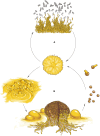Myxobacteria: Moving, Killing, Feeding, and Surviving Together
- PMID: 27303375
- PMCID: PMC4880591
- DOI: 10.3389/fmicb.2016.00781
Myxobacteria: Moving, Killing, Feeding, and Surviving Together
Abstract
Myxococcus xanthus, like other myxobacteria, is a social bacterium that moves and feeds cooperatively in predatory groups. On surfaces, rod-shaped vegetative cells move in search of the prey in a coordinated manner, forming dynamic multicellular groups referred to as swarms. Within the swarms, cells interact with one another and use two separate locomotion systems. Adventurous motility, which drives the movement of individual cells, is associated with the secretion of slime that forms trails at the leading edge of the swarms. It has been proposed that cellular traffic along these trails contributes to M. xanthus social behavior via stigmergic regulation. However, most of the cells travel in groups by using social motility, which is cell contact-dependent and requires a large number of individuals. Exopolysaccharides and the retraction of type IV pili at alternate poles of the cells are the engines associated with social motility. When the swarms encounter prey, the population of M. xanthus lyses and takes up nutrients from nearby cells. This cooperative and highly density-dependent feeding behavior has the advantage that the pool of hydrolytic enzymes and other secondary metabolites secreted by the entire group is shared by the community to optimize the use of the degradation products. This multicellular behavior is especially observed in the absence of nutrients. In this condition, M. xanthus swarms have the ability to organize the gliding movements of 1000s of rods, synchronizing rippling waves of oscillating cells, to form macroscopic fruiting bodies, with three subpopulations of cells showing division of labor. A small fraction of cells either develop into resistant myxospores or remain as peripheral rods, while the majority of cells die, probably to provide nutrients to allow aggregation and spore differentiation. Sporulation within multicellular fruiting bodies has the benefit of enabling survival in hostile environments, and increases germination and growth rates when cells encounter favorable conditions. Herein, we review how these social bacteria cooperate and review the main cell-cell signaling systems used for communication to maintain multicellularity.
Keywords: Myxococcus xanthus; motility; multicellularity; predation; prokaryotic development.
Figures



Similar articles
-
The Predation Strategy of Myxococcus xanthus.Front Microbiol. 2020 Jan 14;11:2. doi: 10.3389/fmicb.2020.00002. eCollection 2020. Front Microbiol. 2020. PMID: 32010119 Free PMC article. Review.
-
Myxococcus xanthus Growth, Development, and Isolation.Curr Protoc Microbiol. 2015 Nov 3;39:7A.1.1-7A.1.21. doi: 10.1002/9780471729259.mc07a01s39. Curr Protoc Microbiol. 2015. PMID: 26528785
-
Coupling cell movement to multicellular development in myxobacteria.Nat Rev Microbiol. 2003 Oct;1(1):45-54. doi: 10.1038/nrmicro733. Nat Rev Microbiol. 2003. PMID: 15040179 Review.
-
MglC, a Paralog of Myxococcus xanthus GTPase-Activating Protein MglB, Plays a Divergent Role in Motility Regulation.J Bacteriol. 2015 Nov 16;198(3):510-20. doi: 10.1128/JB.00548-15. Print 2016 Feb 1. J Bacteriol. 2015. PMID: 26574508 Free PMC article.
-
Myxococcus xanthus predation: an updated overview.Front Microbiol. 2024 Jan 24;15:1339696. doi: 10.3389/fmicb.2024.1339696. eCollection 2024. Front Microbiol. 2024. PMID: 38328431 Free PMC article. Review.
Cited by
-
Harnessing Gram-negative bacteria for novel anti-Gram-negative antibiotics.Microb Biotechnol. 2024 Nov;17(11):e70032. doi: 10.1111/1751-7915.70032. Microb Biotechnol. 2024. PMID: 39487848 Free PMC article. Review.
-
The Predatory Properties of Bradymonabacteria, the Representative of Facultative Prey-Dependent Predators.Microorganisms. 2024 Oct 3;12(10):2008. doi: 10.3390/microorganisms12102008. Microorganisms. 2024. PMID: 39458317 Free PMC article.
-
Unravelling a diversity of cellular structures and aggregation dynamics during the early development of Myxococcus xanthus.Biol Lett. 2024 Oct;20(10):20240360. doi: 10.1098/rsbl.2024.0360. Epub 2024 Oct 23. Biol Lett. 2024. PMID: 39439355 Free PMC article.
-
Protein aggregation is a consequence of the dormancy-inducing membrane toxin TisB in Escherichia coli.mSystems. 2024 Nov 19;9(11):e0106024. doi: 10.1128/msystems.01060-24. Epub 2024 Oct 8. mSystems. 2024. PMID: 39377584 Free PMC article.
-
Co-zorbs: Motile, multispecies biofilms aid transport of diverse bacterial species.bioRxiv [Preprint]. 2024 Aug 29:2024.08.29.607786. doi: 10.1101/2024.08.29.607786. bioRxiv. 2024. PMID: 39257784 Free PMC article. Preprint.
References
-
- Abellón-Ruiz J., Bernal-Bernal D., Abellán M., Fontes M., Padmanabhan S., Murillo F. J., et al. (2014). The CarD/CarG regulatory complex is required for the action of several members of the large set of Myxococcus xanthus extracytoplasmic function σ factors. Environ. Microbiol. 16 2475–2490. 10.1111/1462-2920.12386 - DOI - PubMed
-
- Aguilar C., Eichwald C., Eberl L. (2015). “Multicellularity in bacteria: from division of labor to biofilm formation,” in Evolutionary Transition to Multicellular life, Advances in Marine Genomics, eds Ruiz-Trillo I., Nedelcu A. M. (Dordrecht: Springer Science Business Media; ), 79–95. 10.1007/978-94-017-9642-2 - DOI
Publication types
LinkOut - more resources
Full Text Sources
Other Literature Sources


